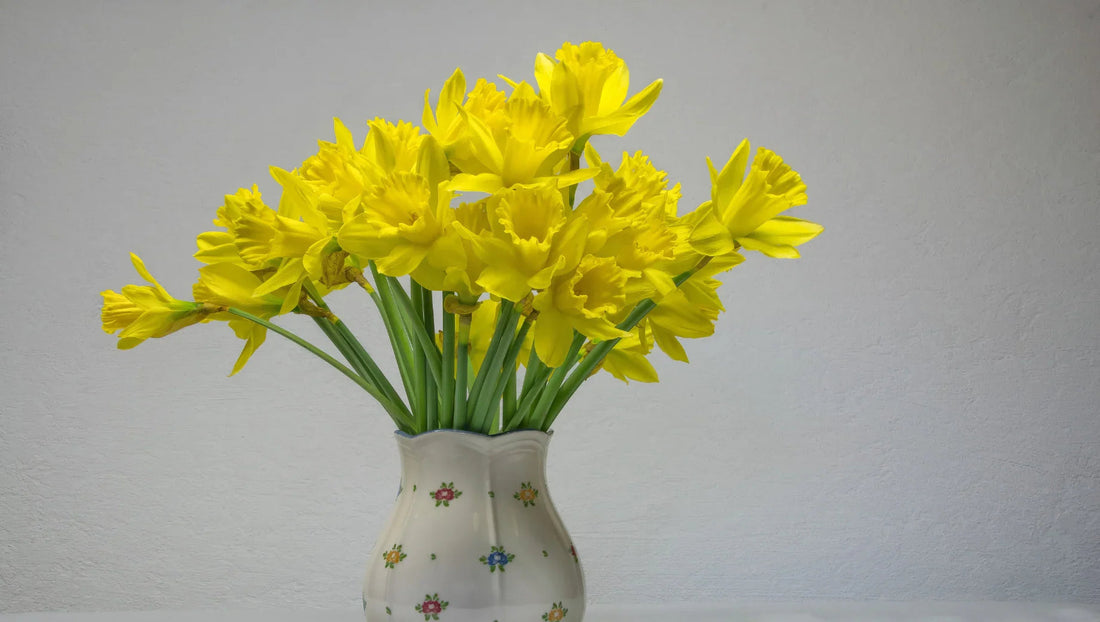
The Meaning of Daffodils (Narcissus): Symbolism, History, and Cultural Significance
Share
The daffodil, scientifically known as Narcissus, is a bright and cheerful flower widely recognized for its distinctive trumpet-shaped bloom and vibrant yellow color. As one of the first flowers to bloom in spring, the daffodil carries rich symbolism and cultural importance across many countries and traditions.
Whether you’re a flower enthusiast, a gardener, or someone curious about floral meanings, this comprehensive guide will explore the meaning of daffodils, their historical roots, cultural relevance, and practical uses.
Symbolism and Meaning of Daffodils
1. Hope and Renewal
Daffodils are often seen as heralds of spring, symbolizing new beginnings, renewal, and hope. Their early bloom after the cold winter months represents the promise of warmer days and fresh opportunities, making them popular flowers for conveying encouragement and optimism.
2. Self-Love and Confidence
Inspired by the Greek myth of Narcissus, a young man who fell in love with his own reflection, the daffodil also symbolizes self-respect, confidence, and appreciation of one’s own worth. This dual meaning serves as a reminder to embrace self-love in a healthy and balanced way.
3. Good Fortune and Prosperity
In many cultures, daffodils are considered to bring good luck, wealth, and prosperity. Gifting daffodils is often seen as a way to wish someone success and abundance in life, particularly during significant life events or celebrations.
Historical and Mythological Background
The name Narcissus comes from Greek mythology. Narcissus was a beautiful youth who became so enamored with his own reflection in a pool of water that he was unable to leave it, eventually transforming into the flower that bears his name. This myth explains the flower’s association with beauty and self-obsession.
Throughout history, daffodils have also appeared in art and literature as symbols of rebirth and hope. In Victorian flower language (floriography), daffodils represented regard and unrequited love.
Daffodils in Different Cultures
- United Kingdom: The daffodil is a national symbol of Wales and is worn proudly on St. David’s Day. It is also used by cancer charities as a symbol of hope and awareness.
- China: The daffodil is associated with good fortune and is commonly used in New Year celebrations to bring prosperity for the coming year.
- Japan: Celebrated for its beauty and delicate fragrance, the daffodil appears in poetry and gardens symbolizing the arrival of spring.
Care Tips for Growing Healthy Daffodils
If you want to enjoy the beauty and symbolism of daffodils in your own garden, consider these tips:
- Planting Time: Daffodils should be planted in the fall before the ground freezes.
- Sunlight: They thrive in full sun to partial shade.
- Soil: Well-drained soil is essential to prevent bulb rot.
- Watering: Moderate watering; avoid overwatering during dormancy.
- Maintenance: Remove spent flowers to encourage bulb strength for the next season.
Using Daffodils in Floral Arrangements and Gifts
Daffodils add a cheerful and elegant touch to bouquets and floral decorations. Their bright yellow hue pairs well with spring flowers like tulips and hyacinths. Because of their positive symbolism, they are excellent gifts for birthdays, graduations, housewarmings, and to brighten someone's day after illness.
Final Thoughts: Why Choose Daffodils?
The daffodil’s vibrant color and rich symbolism make it a timeless flower for expressing hope, renewal, and self-worth. Whether you send them as a meaningful gift or plant them in your garden, daffodils inspire optimism and joy.
By understanding their deeper meanings and cultural significance, you can choose daffodils to perfectly express your sentiments in both personal and professional contexts.
